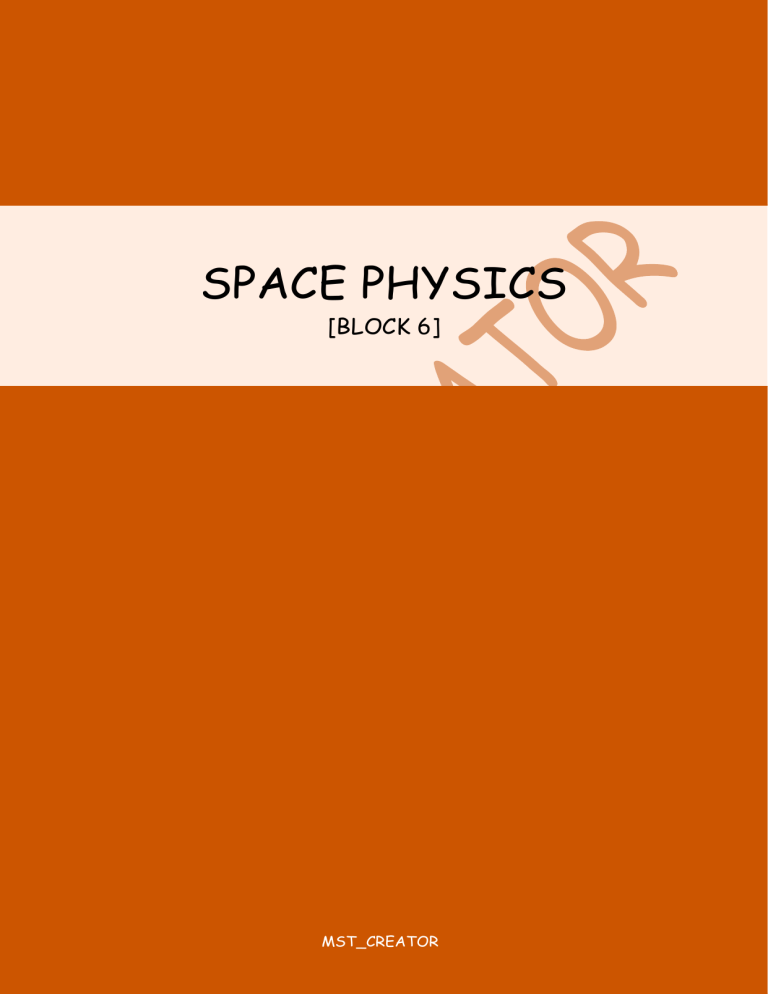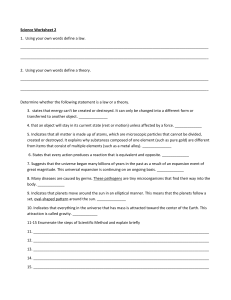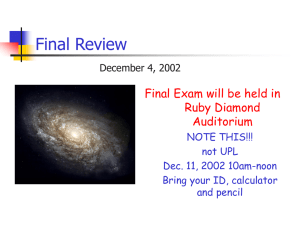
SPACE PHYSICS [BLOCK 6] MST_CREATOR FOLLOW ME ON: Table of Contents Note From Author .................................................................................................................................................. 2 Earth & The Solar System .................................................................................................................................... 3 Motion of The Earth .......................................................................................................................................... 3 Day & Night Cycle........................................................................................................................................... 3 Rising & Setting of The Sun ........................................................................................................................ 3 The Seasons..................................................................................................................................................... 3 Motion of The Moon ........................................................................................................................................... 5 Phases................................................................................................................................................................ 5 Rising & Setting .............................................................................................................................................. 5 Orbital Speed ...................................................................................................................................................... 6 The Solar System ............................................................................................................................................... 6 Asteroids .......................................................................................................................................................... 7 Comets .............................................................................................................................................................. 7 Elliptical Orbits .............................................................................................................................................. 7 Origin ..................................................................................................................................................................... 8 How They Formed .......................................................................................................................................... 8 Planet Gravitational Field Strength ............................................................................................................... 9 Travel Times ........................................................................................................................................................ 9 Planetary Data ................................................................................................................................................... 10 Stars & The Universe............................................................................................................................................ 11 The Sun as a Star .............................................................................................................................................. 11 Nuclear Reactions in Stars ......................................................................................................................... 11 Stars .................................................................................................................................................................... 12 Light Years ..................................................................................................................................................... 12 Galaxies........................................................................................................................................................... 12 The Life Cycle of a Star ............................................................................................................................. 13 The Universe ...................................................................................................................................................... 14 The Milky Way (Again) ................................................................................................................................ 14 The Expanding Universe ............................................................................................................................. 14 Microwave Background Radiation.............................................................................................................. 14 Hubble’s Law .................................................................................................................................................. 15 Notes By MST_Creator Page 1 FOLLOW ME ON: Note From Author I would just like to tell you that my notes may be missing some things here and there or may have some unneeded information every now and then, sorry about that. It’s kind of hard to make notes with a book that has information embedded inside the many paragraphs and having that as my only resource makes the process even more troublesome. Anyway, that’s all for this section, now you can start with the actual content! Hope this helps! Notes By MST_Creator Page 2 FOLLOW ME ON: Earth & The Solar System Motion of The Earth Day & Night Cycle Day and night is caused by the constant rotation of Earth on its axis. The earth makes a revolution every 24 hours, this means that in one half of the time (12 hours), it is daytime and in the other half, it is night-time. Rising & Setting of The Sun The rotation of the earth on its axis causes the sun to rise from east and set at west. The Seasons There are 2 factors that cause seasons, one being the fact that it takes the earth around 365 days to complete an orbit around the sun and the other is the tilt of the Earth on its axis (23.5)ﹾ. Notes By MST_Creator Page 3 FOLLOW ME ON: Figure 1 Part Season Day & Night Length Hemisphere Tilt BCD Spring & Summer Long Days Short Nights Northern hemisphere tilted away from the sun Autumn & Winter Short Days Long Nights FGH Southern hemisphere tilted away from the sun Part Date Northern Hemisphere Day & Night Length Southern Hemisphere Day & Night Length C June 21st Longest Day Shortest Night Shortest Day Longest Night G December 21st Shortest Day Longest Night Longest Day Shortest Night A & E March 20th And September 23rd Night & Day Have Same Length (Equinox) Night & Day Have Same Length (Equinox) Notes By MST_Creator Page 4 FOLLOW ME ON: Motion of The Moon Phases The moon completes an orbit around the sun in a month. As the moon rotates around the earth, it appears differently to us, this means that the moon has phases. Figure 2 Image From timeanddate.com The shaded parts are the parts which we don’t see as the sun light does not go onto them. Rising & Setting The tilt of the Earth on its axis causes the moon to rise from the east and set at the west. Notes By MST_Creator Page 5 FOLLOW ME ON: Orbital Speed To calculate the average orbital speed, we use the formula: 𝑣= 2𝜋𝑟 𝑇 𝐴𝑣𝑒𝑟𝑎𝑔𝑒 𝑂𝑟𝑏𝑖𝑡𝑎𝑙 𝑆𝑝𝑒𝑒𝑑 = 𝑂𝑟𝑏𝑖𝑡 𝐶𝑖𝑟𝑐𝑢𝑚𝑓𝑒𝑟𝑒𝑛𝑐𝑒 𝑂𝑟𝑏𝑖𝑡𝑎𝑙 𝑃𝑒𝑟𝑖𝑜𝑑 Orbital Period is the time taken to complete 1 orbit Average orbital speed is the speed of an object that is orbits around a body. The Solar System The solar system is made of: Name The sun Eight Planets Asteroid Belt Moons Minor Planets Smaller Bodies Notes By MST_Creator Description This is a start that is in the middle and is the heart of the Solar System. Inner Planets: Outer Planets: 1. Mercury 1. Jupiter 2. Venus 2. Saturn 3. Earth 3. Uranus 4. Mars 4. Neptune They are smaller, solid, rocky, They are large, colder, have have a layered structure, and low densities, and are mainly have high densities. made up of gases. This is a belt of asteroids going around the sun, it can be found between Mars & Jupiter. These are the moons that orbit the planets in the solar system. (Like IO, Europa, Phobos, etc) These are dwarf planets (like Pluto or Ceres) and certain asteroids from the asteroid belt. Like comets (i.e., Halley’s Comet) & other small bodies. Page 6 FOLLOW ME ON: Asteroids An asteroid is any object that orbits a star and does not have a large enough mass for gravitational attraction to pull it into spherical shape. Asteroids are classified as minor planets. Comets Comets are objects that consist of a nucleus of ice and dust. When comets are near the sun, they develop a bright head and long tail that points away from the sun. Elliptical Orbits Elliptical orbit basically refers to the path an object orbits around another object: Figure 3 Figure 4 Image Source: NSO Elliptical orbit of a comet This is the elliptical orbit of a planet around the sun As you saw in both figures, the sun was inside the elliptical orbit, but not in the middle, the reason for this is that the sun is never in the middle of an elliptical orbit unless the orbit is perfectly circular. In Figure 4, we can see that the elliptical orbit of a comet is in an oval shape, it shows us that the speed of the comet increases as it approaches the sun and decreases as it moves away, energy is conserved as the kinetic energy the comet had when near the sun is converted to potential energy. Notes By MST_Creator Page 7 FOLLOW ME ON: Origin How They Formed Formation Sun Formed when gravitational attraction pulled clouds of Hydrogen gas and dust. Planets First, the matter that was left after creating the sun formed an accretion disk, gravitation attraction eventually pulled the matter together to form planets. Planet Formation Planets Group Position Properties Inner Between Sun & Asteroid Belt Dense Small Rocky Layered Structure As the sun grew, it became hotter. This meant that the area of the inner planets would also be very hot, this caused light molecules to be in gaseous or liquid form. Property Reasoning This meant that the inner planets would be made of matter with high melting points which also meant that they would be dense, these included metals and silicates. Since there was a low number of heavy elements, this resulted with the inner planets being small, rocky, and solid. Outer After Asteroid Belt Low Density Large Mainly Made of Gases Cold Since these planets were in the colder region, far from the sun. This meant that the light molecules were able to exist as solids. This meant that they would be made of the lighter molecules which had low melting points and were less dense, these included Hydrogen, Methane, Water, etc. Since most of the leftover matter was the light elements, this resulted with the outer planets being large and gaseous. Some Things to Know About the Sun The sun makes up most of the mass of the Solar System (more than 99%). Another thing is that the force that causes the objects (like planets) to keep orbiting the sun is the gravitational attraction of the sun. Notes By MST_Creator Page 8 FOLLOW ME ON: Planet Gravitational Field Strength Gravitational field strength of a planet depends on the mass of the planet. Planet Mass Gravitational Field Strength Increase Increase Decrease Decrease 𝑃𝑙𝑎𝑛𝑒𝑡 𝑀𝑎𝑠𝑠 ∝ 𝐺𝑟𝑎𝑣𝑖𝑡𝑎𝑖𝑜𝑛𝑎𝑙 𝐹𝑖𝑒𝑙𝑑 𝑆𝑡𝑟𝑒𝑛𝑔𝑡ℎ Gravitational Field Strength acting on an object decreases as the distance between the object and the planet increases. Distance Between Object & Planet Gravitational Field Strength Increase Decrease Decrease Increase 𝐷𝑖𝑠𝑡𝑎𝑛𝑐𝑒 𝐵𝑒𝑡𝑤𝑒𝑒𝑛 𝑂𝑏𝑗𝑒𝑐𝑡 & 𝑃𝑙𝑎𝑛𝑒𝑡 ∝ 1 𝐺𝑟𝑎𝑣𝑖𝑡𝑎𝑖𝑜𝑛𝑎𝑙 𝐹𝑖𝑒𝑙𝑑 𝑆𝑡𝑟𝑒𝑛𝑔𝑡ℎ Travel Times To calculate the amount of time light takes to travel through space, we can use: 𝑆𝑝𝑒𝑒𝑑 = 𝐷𝑖𝑠𝑡𝑎𝑛𝑐𝑒 𝑇𝑖𝑚𝑒 We can then rearrange the formula to give time: 𝑇𝑖𝑚𝑒 = 𝐷𝑖𝑠𝑡𝑎𝑛𝑐𝑒 𝑆𝑝𝑒𝑒𝑑 Note: Speed refers to the speed of light (3 x 108) The value for distance is given in the question. Notes By MST_Creator Page 9 FOLLOW ME ON: Planetary Data One of the requirements in the 2023 syllabus is to analyse and interpret planetary data for various things. We get this table for reference: Figure 5 Table With Data for Each Planet Here is the reasoning for the required things: Value How It Changes Orbital Distance Increases as distance from the sun increases. Orbital Speed Decreases as distance from the sun increases. Orbit Duration Increases as distance from the sun increases. Surface Temperature Density Decreases as distance from sun increases (except Venus which has high surface temperature due to its carbon clouds which traps heat). Decrease as distance from sun increases (except Uranus & Saturn, they are ice giants, so they have more density than gas giants) Surface Gravity Notes By MST_Creator Reasoning This happens because the elliptical orbit grows larger because the distance from the sun increases. As the distance from the sun increases the gravitational field decreases which means that the centripetal force is weaker, this decreases the orbital speed and increases the orbital duration. Sun emits infrared radiation; the intensity of this radiation decreases as we go farther from the sun. Discussed in planet formation Discussed in Planet Gravitational Field Strength Page 10 FOLLOW ME ON: Stars & The Universe The Sun as a Star Star Size Medium Elements Hydrogen & Helium Energy Emitted Infrared rays, Visible Light, and UV rays Nuclear Reactions in Stars Stars are powered by nuclear reactions. These reactions are fusion reactions of Hydrogen & Helium. Remember that these reactions can only occur in stars that are stable and have a hot and dense enough core to carry out the fusion reactions. Why The High Temperature? The high temperature in the core is needed to sustain the nuclear reactions and is maintained large amount of energy release in the fusion process. How It Glows Some of the energy that is generated at the core is transferred to the outer layers of the star. The outer layers are cooler and not as dense as the core but still allow the Hydrogen gas to glow and emit EM radiation into space. Notes By MST_Creator Page 11 FOLLOW ME ON: Stars Light Years One light year is the distance travelled by light in a vacuum in one year. 1 light year = 9.5 x 1012 km Galaxies A galaxy is a large collection of stars. Galaxies also consist of clouds of gas (mostly Hydrogen & dust) and they many rotate in spiral disks The Milky Way The sun is a star that is in a galaxy called the milky way. The solar system is also located in the milky way. Unlike the sun, other stars are located light years away from the Earth. Notes By MST_Creator Page 12 FOLLOW ME ON: The Life Cycle of a Star Stage 1 2 3 4 What Happens Interstellar clouds of dust & gas including Hydrogen collapse under the gravitational attraction and forms a protostar. As the protostar’s mass increases, so does its temperature. The protostar contracts under the internal gravitation forces and when the core is hot enough, the fusion reaction starts where Hydrogen turns to Helium. The protostar becomes stable when the gravitation attraction force pulling inwards is balanced out by the force of expansion due to the high temperature. When the star starts to run out of Hydrogen as fuel for the nuclear reactions, it becomes unstable because the balance between the forces pulling inward and the forces pulling outward has been disturbed. When this happens, the core becomes extremely hot, and the remaining hydrogen is burned up fast and the surface is cooled down. Low Mass Stars High Mass Stars When the red giant runs out of helium, the red giant collapses under its own gravity and releases enough energy to expel some of its outer layers. This means that the core becomes a white dwarf at the center of a glowing shell of ionised gas called planetary nebula. When the red supergiant runs out of helium, the core collapses further into gravity and hot enough for nuclear fusion of Carbon into Oxygen, Nitrogen, and Iron to occur. Nuclear fusion then stops and is released in a supernova explosion. In supernova explosions, star’s brightness increases, and the core is hot enough for fusion of many elements heavier than iron and becomes available for the formation of new stars and planetary systems. The center of the supernova collapses to a dense neutron star and if the center is very dense, black hole is formed Notes By MST_Creator What Forms Protostar Large Mass: Blue or White Star Smaller Mass: Red dwarf or Yellow dwarf Red giant but it can also be a red supergiant if the star if the star is very massive. Low Mass Star White dwarf with glowing ionised gas around it. (The white dwarf eventually becomes a black dwarf) High Mass Stars A Neutron star forms which acts as pulsar and sends out radio wave pulses. A Black hole forms when the center is extremely dense, a Black hole sucks anything into it, from solids to gases. Page 13 FOLLOW ME ON: The Universe The Milky Way (Again) The milky way galaxy is one of the many galaxies in the universe. The diameter of the milky way is 100,000 light years and is made up of more than 800 billion stars. The Expanding Universe Redshift Redshift is when the light emitted from stars in distant galaxies is shifted to the red end of the spectrum, this means that it increases the wavelength. Another thing to note is that the greater the distance between the observer and the star, the more the redshift. Redshift supports the fact that the universe is expanding & the big bang theory. The Big Bang Theory The theory suggests that all the matter of the universe was packed in a dense state, it tells us that an explosion took place (the big bang) around 14 billion years ago. The expansion of the universe continues to this day. (Extremely short summary of the idea, hope it helps) Microwave Background Radiation The big bang produced radiation energy which exists in the universe as Cosmic Microwave Background Radiation (CMBR) of a certain frequency. CMBR fills the whole universe with similar intensities. As the universe has expanded over the years, this caused the CMBR to redshift into the microwave region of the EM spectrum. Notes By MST_Creator Page 14 FOLLOW ME ON: Hubble’s Law This law states that: “The velocity of the galaxy which is also known as the redshift is directly proportional to its distance.” (Source: Byjus) Formula: 𝑣 = 𝐻0 × 𝑑 Quantity Description How To Find It v Speed at which the galaxy is moving away from the Earth. Found from the change in wavelength of the galaxy’s starlight due to redshift. H0 Ratio of the speed at which a galaxy is moving away from the earth and the distance between the galaxy and the Earth. 𝑣 (𝑑 ) It’s a ratio, you must calculate it using the other 2 quantities. d Distance between the galaxy and the earth. Calculated using the brightness of a supernova in that galaxy. Current Estimate of H0 The current estimate for H0 is 2.2 x 10-18 per second. Calculating The Age of The Universe We can rearrange the formula of Hubble’s law to get the age of the universe: 𝑑 1 = 𝑣 𝐻0 𝑑 𝑣 refers to the age of the universe so we can say: 𝑎𝑔𝑒 = 1 𝐻0 This means that the age would be around 4.5 x 1017 seconds. We can simplify this value into years by dividing by 31,536,000 giving us: 1.4 x 1010 which is 14 billion years! (It’s a rough estimate as I reduced the values to 1 d.p) Notes By MST_Creator Page 15 FOLLOW ME ON: Thanks For Reading! If this helped you in any way… I am happy for you Notes By MST_Creator Page 16






